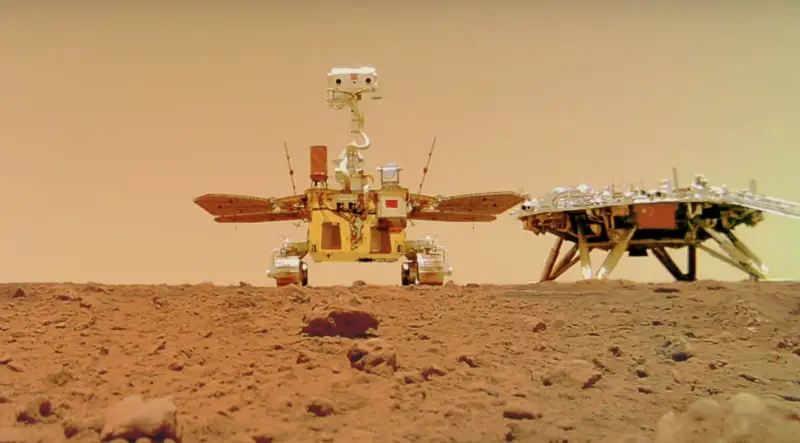The quest to understand the nature of ancient Mars inspired our space agencies to launch several space missions to Mars. The China National Space Administration (CNSA) is one of the biggest players in exploring Mars in search of evidence for ancient life. On July 23, 2020, CNSA launched the Tianwen 1 space probe consisting of an orbiter, a lander, and a Zhurong Mars Rover.
The space probe arrived at Mars Orbit on February 10, 2021. Upon arriving at Mars orbit, the orbiter commenced operation immediately. On May 14, 2021, the Zhurong Mars Rover and the lander safely touched down on Mars’ surface. Upon the safe landing, the rover and lander commenced full operation on the Mars surface, returning new unique data to CNSA’s control center on Earth.
Currently, the Zhurong Mars rover has covered up to 6,302 feet (1,921 meters) on the Martian surface. CGTN Television Network, a Chinese state-run media network recently stated that the CNSA has received up to 1,480 gigabytes of raw data from its orbiter and rover exploring Mars. Some of the information provided by the data shows that an ancient ocean was once in existence in the Utopia Planitia. The Zhurong Mars rover has been exploring the massive Martian plain of Utopia Planitia for a while now. The rover was able to make the discovery based on its experience in the vast plain.
How CNSA Interpreted the data and make the discovery
After CNSA received the 1,480 gigabytes of raw data from its orbiter and rover, Chinese scientists commenced the task of analyzing the data to obtain more information from it. Based on their analysis, they noticed the existence of hydrated minerals contained in the duricrust. Duricrust is a hard-mineral layer that exists as surface soil and it is basically formed because of the evaporation of groundwater.
Scientists were so fascinated with this discovery and suggested that the discovery provides evidence of liquid water present in the Utopia Planitia of Mars billions of years ago. This observation inspired the scientists to suggest that erosion due to wind or water might have caused the Mars soil to be made up of high bearing strength and low friction parameters.
Can we prove the existence of Water on Mars?
For years, scientists have been analyzing data collected from the red planet to determine the evidence of ancient water on Mars’ surface. In fact, ancient astronomers once believed that there is abundant water on the Martian surface. However, modern space technologies unveiled more unique facts about Mars to humanity. After NASA’s Curiosity Rover discovered the first evidence of ancient water on the Martian surface, scientists have been fascinated with Curiosity’s discovery and they hope to learn more from future space missions.
In 2016, NASA’s Mars Reconnaissance Orbiter returned data showing evidence of a water ice deposit beneath the Utopia Planitia. Zhurong Mars rover making similar observations shows that ancient oceans may have existed on the Martian surface. As NASA, CNSA, SpaceX and other space agencies are working toward sending astronauts to the red planet before 2040, we need to continue our scientific research to ensure that we figure out the best sports for our astronauts to explore upon landing on the Martian surface.
Conclusion
Recent mars data provided by the Tianwen 1 and Zhurong has shown that ancient Mars may have a different environment from the present hostile conditions of the red planet. The orbiter and the Mars rovers will continue to advance their exploration on the red planet and make more discoveries for humanity.





